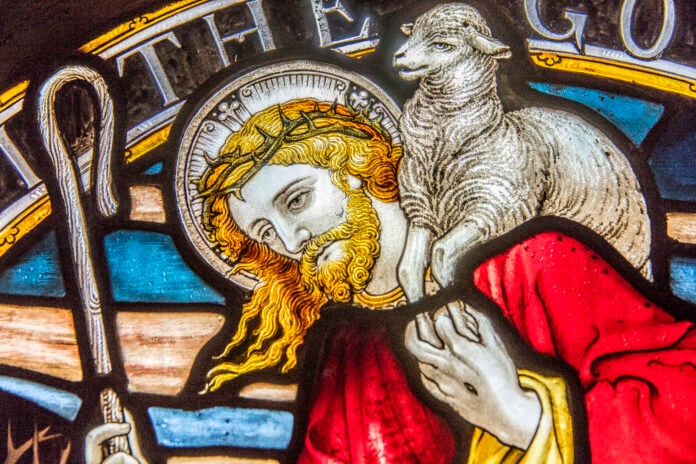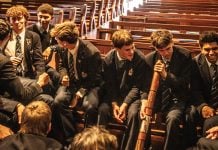It is a cliché to begin an article on chapel choirs with the words soaring, mystery, wonder and tradition. And yet these words hit the nail on the head. They sum up what we experience and reflect upon, when we consider what chapel choirs offer to those inside and outside their ranks.
Through singing about God, and to God, church choirs are a catalyst for bridging the gap between heaven and earth, eternity and mortality. Like scripture and doctrine, they aspire to draw us closer to the great ineffable, that which St John summed up as “God is love”.
The maxim “He who sings prays twice” is most frequently attributed to St Augustine (354-430), but it is no surprise to find both Catholic and protestant claims to this saying, for it is self-evident that music magnifies, refracts and intensifies emotion: in performance it gives transient rebirth to a reliving of the essence and nuance of sacred text. It is praying twice, for it is ideally the combined and heightened expression of mind and heart, body and soul.
We easily imagine endless medieval movie recreations of monks in monasteries and nuns in convents singing. The singing classification ‘tenor’ comes from this tradition. The earliest evidence of harmonic singing, organum, rather than unison chant, comes from the Middle Ages, and was typically improvised. Those singing the original chant were the tenors, from the Latin tenere, to hold: they held the tune. Improvising monks with lower voices, basses, from basso: low, sang below the chant, while against the tenors, countertenor, could be a higher part, perhaps in men’s falsetto, otherwise known as alto from altus: high. And above it all, in the characteristically soaring lines, came the sopranos, or trebles, from super: above. This part was sung by boys.
The formation of ecclesiastical choirs began with monks, nuns and priests singing their daily prayers. The call to sing abounds in scripture:
Then Moses and the Israelites sang this song to the Lord: “I will sing to the Lord, for he is highly exalted.
(EXODUS 15:1)
Come, let us sing for joy to the Lord; let us shout aloud to the Rock of our salvation.
(PSALM 95:1)
Let the message of Christ dwell among you richly as you teach and admonish one another with all wisdom through psalms, hymns, and songs from the Spirit, singing to God with gratitude in your hearts.
(COLOSSIANS 3:16)
The trumpeters and musicians joined in unison to give praise and thanks to the Lord. Accompanied by trumpets, cymbals and other instruments, the singers raised their voices in praise to the Lord and sang: “He is good; his love endures forever.”
(2 CHRONICLES 5:13)
In time, as musical prayer evolved, clergy found themselves deputising their sung prayers to those with more sophisticated musical skills: a separation of choir and clergy evolved. The clerical function the Chapel Choir is evident in Melbourne Grammar School’s Chapel of St Peter: the choir sits in the sanctuary, in large stalls intended for clergy and choristers only, fashioned in the ancient monastic tradition of opposite sides, facing each other. To this day, monastic music making features alternation between one side of the Chapel and the other. Additionally, the choristers and clergy wear surplices: sacred white linen vestments evoking the white garments worn at baptism; and loose to reflect freedom from original sin.
And so, while the tradition of chapel choirs is the evolution of pragmatic considerations and musical style, it is in some senses, too, a tradition resurrected in the 19th century. King’s College, Cambridge, was founded in 1446, but the centenary of its famous Festival of Lessons and Carols occurred as recently as 2018.
In the Church of England, the Oxford (High Church) Movement, which developed into the Anglo-Catholic movement, began in the 1830s. It sought to restore the ideals of the pre-Reformation church, as evidenced, for instance, by the Anglican nuns in Call the Midwife.
The influence can be felt very strongly at St Peter’s, Eastern Hill, where The Diocesan School for Boys, the precursor to Melbourne Grammar School, was situated. The Anglo-Catholic movement shaped much of our Melbourne Grammar tradition: the French Gothic style of the Chapel with an east/west axis, the dedication to St Peter, the displaying of a crucifix, the prominent Last Supper panel, a high altar where the Chaplain stood with his back to the congregation during the Holy Communion, and a monastic school motto from St Benedict, “Ora et Labora”.
Then, as now, communal singing unites congregations in purpose and prayer. One of the annual musical highlights in the Chapel of St Peter is the singing of The School Hymn, Ora et Labora, and I Vow to Thee My Country at the Year 12 Leavers’ Eucharist. And in contrast to Queen Elizabeth I’s declaration regarding the Catholic and protestant factions within her Church of England “I would not open windows into men’s souls”, there’s no need for peering into the souls of men during these hymns by all those soon to be Old Melburnians: the windows are wide open, the curtains flapping outside.
It is in singing by itself as a choir, however, that the more sophisticated and complex musical communications are made in divine service. The art of the choristers draws on a much broader palate than that of the congregation. The choir’s role is to draw the assembled to that emotional communication – indeed while some areas of Christendom are fixated with unity of communal participation, it could be argued that active listening offers more breadth of participation and experience than active singing alone. It strikes me that seeking satisfaction from listening to music, rather than performing it, is the norm. There’s room for both.
Many cultural norms were tested in the 1960s, and the Melbourne Grammar liturgical model of Chapel Choir and organ, once ubiquitous, is now something of a rarity. But it is a model that fits the School well, and is flourishing. It demands and warrants, dedication, talent and hard work. “The musical tradition of the universal Church is a treasure of inestimable value, greater even than that of any other art.” (Catechism of the Catholic Church, paragraph 1156)
In closing, some thoughts from radical composer Igor Stravinsky, in response to the cultural upheavals of the second half of the 20th century:
How much poorer we are without the sacred musical services, without the Masses, the Passions, the round-the-calendar cantatas of the Protestants, the motets and sacred concerts, and vespers and so many others. These are not merely defunct forms but parts of the musical spirit in disuse.
The Church knew what the Psalmist knew: music praises God. Music is as well or better able to praise Him than the building of the church and all its decoration; it is the Church’s greatest ornament. Glory, glory, glory; the music of Orlando Lasso’s motet praises God, and this particular “glory” does not exist in secular music….prayer and penitence and many others cannot be secularized. The spirit disappears with the form. I am not comparing “emotional range” or “variety” in sacred and secular music…. I say simply that, without the Church, “left to our own devices,” we are poorer by many musical forms.
(from Conversations with Igor Stravinsky, 1959)
Philip Carmody
Director of Music



